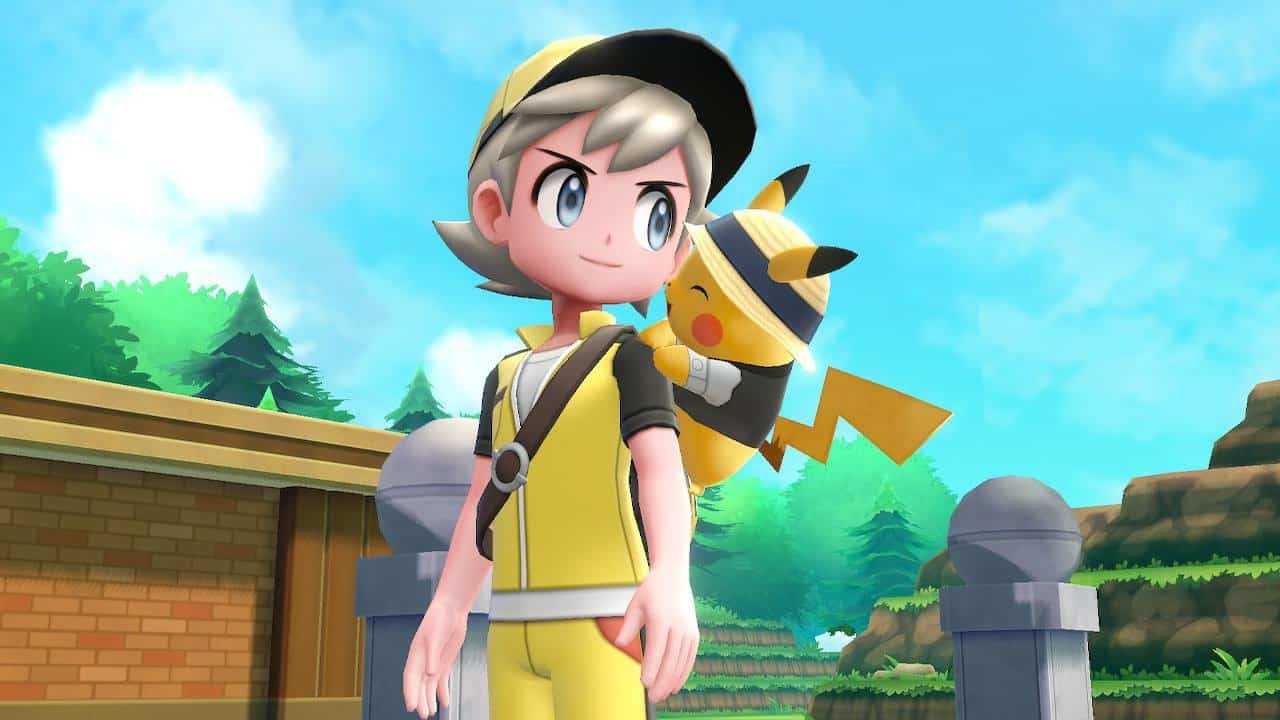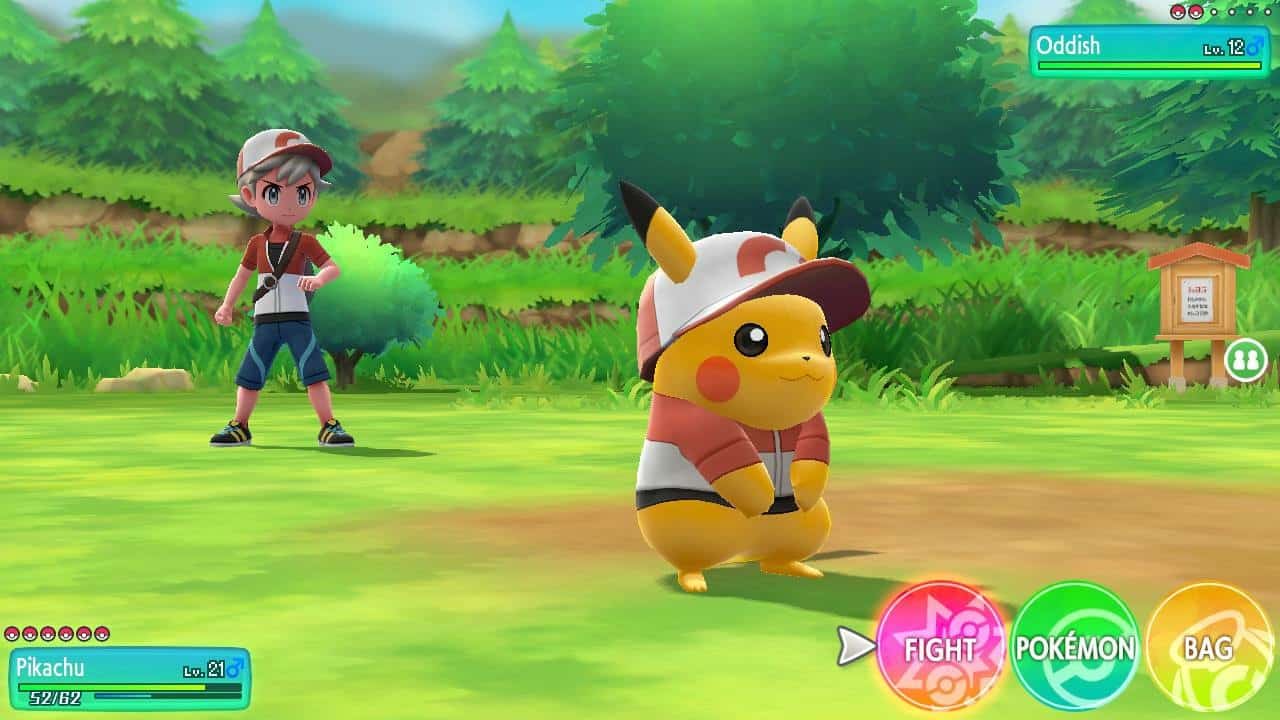
Let’s Go Is The New Yellow
It’s been 20 years (22 in Japan) since Nintendo and Game Freak gave players the chance to embark on the journey to become a Pokémon master. Since that time, Pokémon is a name that has been synonymous with handheld gaming. Now, with the handheld/home console hybrid capabilities of the Nintendo Switch, the series has an opportunity to expand beyond the confines of portable-only experiences.
Not to be confused with the next entry in the main series (slated for a 2019 release), Pokémon Let’s Go Pikachu and Let’s Go Eevee are updates of 1998’s Yellow Version. Most of the additions to the original are as seamless as they are effective, though the motion controlled catching is thoroughly problematic. However, a number of tweaks and modernized mechanics in conjunction with timeless characters and game design make for an experience that’s sure to please Pokémon veterans and newcomers alike.

Classically Beautiful
The visuals in Pokémon Let’s Go are a fantastic, faithful upgrade of the original. Those who played the Gameboy versions will feel like they’re seeing Kanto and the original 150 Pokémon as they were always meant to look. Top-notch character designs and a brilliantly colorful art style make up for the somewhat simplistic graphics.
In addition to aesthetic upgrades, there are visual elements that improve the gameplay experience. Gone are the days of random encounters with wild Pokémon. Walking through the environment, players can see the Pokémon they can encounter, and choose which ones to avoid, and which ones to try capturing.
From an audio standpoint, Let’s Go strikes a perfect balance between nostalgia and modern quality. The familiar sound effects are all here, from the click of a successful pokéball toss to the old-school synthesized cries of the original Pokémon. The original music has been recreated with actual instruments and high-quality synths as well. Prepare to have the game’s soundtrack firmly stuck in your head all over again.

Streamlined Adventure
For the most part, the original structure of the game remains intact. Players receive their first Pokémon and set off to acquire gym badges and challenge the elite four. Thankfully, the need for grinding has been significantly reduced. I almost never had to spend additional time leveling up my party before moving on to the next big battle.
Additionally, a number of changes have been made to expedite tedious sections of the game. Certain moments that used to require backtracking now allow for fast-travel. There are also added healing locations which eliminate the need for walking back to a Pokémon center. The game seems to be designed to not waste your time; something which feels perfectly catered to young, impatient players, as well as returning veterans who have done this all before.
The original games awarded players with abilities like “fly” or “surf” after certain battles. In Let’s Go, several of these abilities are acquired by talking to someone in a specific town. This is a nice way of teaching players to talk to everyone they come across, a practice which provides a number of highly valuable items, Pokémon, and TMs. That being said, I unfortunately didn’t acquire fast travel until late in the game because I missed talking to the person who teaches it.

Catch ’em All Again and Again
The biggest change in the game is the way wild Pokémon encounters work. Rather than battling them, wild Pokémon are captured; much like in Pokémon Go. This takes some getting used to, but eventually it becomes obvious that this is yet another time saver. The amount of time spent on catching a wild Pokémon is cut in half by removing the need to weaken them in battle.
Once you’ve captured a Pokémon that you want in your party, it’s possible to access them from anywhere in the game. Not having to go to a Pokémon center to manage your collection is a major improvement that should become a standard for the series. If you’ve captured a series of the same Pokémon to achieve a combo bonus (for xp as well as increased chances of finding a rare Pokémon), it’s just as easy to send them to the professor for candies that provide a stat boost.
The implementation of the combo bonus is a welcome addition. It’s now possible to find rare Pokémon almost anywhere; simply catching a series of Pidgeys can make an Abra or Chansey appear. I was able to acquire all three original starter Pokémon within the first few hours of the game. Filling the Pokédex also went much faster than it did in the originals.

Less Enemies, More Friendship
During battles, there’s also a random chance that the player will get lucky and avoid an attack or achieve a critical hit. The game describes your Pokémon achieving this bonus “due to your shout” or “in an effort to please you.” It’s a quirky way of saying “to randomly make it easier to win.” Sometimes I felt insulted by this addition, but when battling the elite four I was singing its praises.
Returning players will notice a few interesting changes outside of gameplay as well. For example, the rival character is now your best friend. While it seems like an odd choice at first, it actually fits better within the game’s narrative. Battling with your friend against team rocket makes a lot more sense than competing with a rival to bring them down.
Certain dialogue has also been changed, for debatable reasons. When battling trainers, they are referred to as the “opposing” team rather than the “enemy.” Teaching your Pokémon a new move ends with “ta-da” rather than “poof.”
Joy(less)-Con
Pokémon Let’s Go is a thoroughly catching-centric experience. While this translates to a streamlined path to catching ’em all, the choice to make motion controls mandatory for throwing pokéballs when playing on the television is the game’s singular, unequivocal failure.
While it’s relatively easy to catch low-level Pokémon who stand completely still in the center of the screen, the same can’t be said for most of the Pokémon in the game. I lost count of how many times the motion controls failed and I sent a pokéball sailing in the wrong direction. The legendary birds in particular are an exercise in frustration when playing on the television. The only solution is to play in handheld mode; essentially returning the series to its Gameboy roots.
What’s really unfortunate about this feature is the fact that playing in handheld mode reveals what it could have been. Having an added level of control over the capture process feels like a no-brainer. If the motion controls were used the way they are in handheld mode, it would be a flawless addition to the series. Instead, it makes playing on the television feel like a handicap.

Handheld Or Bust
Aside from the insulting implementation of motion controls when playing on the big screen, Pokémon Let’s Go Pikachu and Let’s Go Eevee are brilliantly executed remakes of a timeless classic. It’s impossible to judge a game so focused on catching Pokémon without considering the controls for those catching sequences, but with the option to fix the problem by playing in handheld mode, it’s not enough to ruin the experience.
The nostalgia level is high, and returning players will spend almost the whole game grinning from ear to ear. The numerous changes which expedite the experience are perfect for keeping that nostalgia flowing, as well as keeping new players interested throughout.
If the motion controls weren’t such a letdown when playing on a television, this game would be nearly flawless in achieving its goals. As it stands, these are two great games that suffer from Nintendo’s infamous overconfidence in motion control accuracy. Pokémon Let’s Go Pikachu and Let’s Go Eevee get a best-played-in-handheld-mode 4.2 out of 5.
Are you ready to leave Pallet town and set out on your journey to becoming a Pokémon master? Pokémon Let’s Go Pikachu and Let’s Go Eevee are available now in a standard edition for $59.99 as well as a bundle containing the Pokéball Plus for $99.99.





Recent Comments